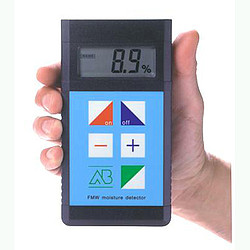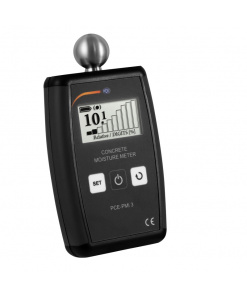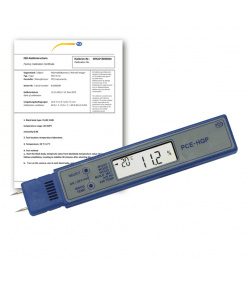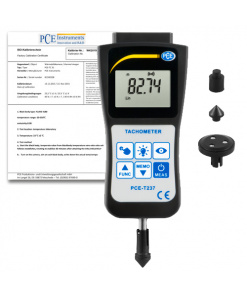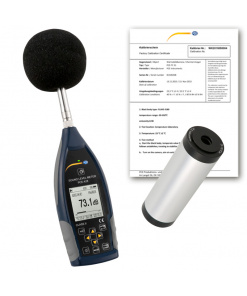Concrete Moisture Meter FMW-T
FMW-T
Availability : กรุณาติดต่อสอบถาม
หมวดหมู่: Concrete Moisture Meter
Concrete Moisture Meter FMW-T to measure humidity without causing any damages in the material
The Concrete Moisture Meter FMW-T covers all your needs while measuring moisture contents in all types of wood and building materials. The Concrete Moisture Meter works without causing any damage to the material and it is mainly employed to measure building walls. When you have to choose a Concrete Moisture Meter it is very important to take into consideration if the surface can be affected or if it has to be in perfect condition after the measurement. Humid areas can produce mould in houses. These areas are easily detected. You will also measure humidity in wood, as for instance in parquet floors.
The Concrete Moisture Meter FMW-T has a compact design and is very easy to use. These characteristics turn the Concrete Moisture Meter into an irreplaceable tool for professional builders, technicians, etc.
The Concrete Moisture Meter FMW-T has a compact design and is very easy to use. These characteristics turn the Concrete Moisture Meter into an irreplaceable tool for professional builders, technicians, etc.
Three-step measuring process:
– Turn-on and zero setting
– Fitting of wood thickness (selected from memory)
– Measuring and reading of moisture content
Adjustments:
– MAX, memory or Scan mode
– Entry of the specific weight of wood from 250…1100kg/m3 in 10 kg intervals
–�Relative values for building materials
Functionality / Measuring principle
The Concrete Moisture Meter FMW-T for wood is guided by a microprocessor-unit to quickly determine moisture content in wood and building materials. The Concrete Moisture Meter measures moisture content when the upper frontal sensor is placed on the material for half a second. It is also possible to measure through paper or paints.
Humidity is determined by contact using a high-frequency technique. Measurements can be taken without damaging the material surface. Therefore, this Concrete Moisture Meter is specifically suited for the use on finished products or for fast controls on site.
The material you want to measure is not important. You will only need to put the frontal side of the Concrete Moisture Meter on the material such as: balsa, beech, birch, cedar, oak, pine, fir-tree, mahogany, lime-tree etc or building materials such as parquet.
Humidity is determined by contact using a high-frequency technique. Measurements can be taken without damaging the material surface. Therefore, this Concrete Moisture Meter is specifically suited for the use on finished products or for fast controls on site.
The material you want to measure is not important. You will only need to put the frontal side of the Concrete Moisture Meter on the material such as: balsa, beech, birch, cedar, oak, pine, fir-tree, mahogany, lime-tree etc or building materials such as parquet.
Characteristic curves of wood and basic indications for measuring
Below you will see an extract of the characteristic curves in alphabetical order of all the most important wood types (they are stored in the Concrete Moisture Meter). We can also send another list with more wood types.
Below you will see an extract of the characteristic curves in alphabetical order of all the most important wood types (they are stored in the Concrete Moisture Meter). We can also send another list with more wood types.
Softwood
– Fir
– Canadian Fir (east, west)
– Agathis (heavy, light)
– Alcere
– Alerce (European, Japanese, Russian)
– Alerce (American, East, West)
– Red Cedar
– Douglasie (heavy, light)
– Mañio
– Pine (European, Nordic)
– Pine (light, heavy, Caribbean, American)
– Pine (European, Nordic, Kern, Spint)
– Pine (French)
– Pine Parana
– Pine Radiata
– Pine Sitka
– Pine Sugar
– Pine Weymouth
– Yellowwood
– Redwood (Californian, heavy, light)
– Sugi
Attention: All the characteristic curves of the wood types of this column and the adjoining one are stored inside the Concrete Moisture Meter FMW-B. They can be displayed by introducing the corresponding gross densities. A chart with all the materials and wood types will be included in the delivery.
To take into account:
While measuring moisture content in wood, the result will be more accurate on smooth surfaces. The measuring value will grow on chips or knots. If measurements are taken on breaks, the humidity value will be lower in relation to the real humidity value (absolute humidity).
In both cases, you will have to measure near the area which is going to be measured.
Measurement accuracy:
Wood has an inhomogeneous composition. Therefore, gross density oscillations can be produced when measuring the same wood type. Therefore, you will have to take various humidity measurements – the measurement result will be the mean value calculated by the Concrete Moisture Meter.
Wood surface:
In rough surface wood types, the result displayed in the Concrete Moisture Meter can be lower.
Fiber direction:
The result will not be affected if the measurement is taken either in the fiber direction or against the fiber direction.
Measurement depth:
The measurement depth is 25 mm. If the wood is very thin (e.g. < 1 cm thickness) measurement will be carried out through the wood. The material on the wood will also be measured partially.
Measuring surface:
During the measurement the Concrete Moisture Meter has to be on the surface which is going to be measured in order to avoid mistakes with results.
– Fir
– Canadian Fir (east, west)
– Agathis (heavy, light)
– Alcere
– Alerce (European, Japanese, Russian)
– Alerce (American, East, West)
– Red Cedar
– Douglasie (heavy, light)
– Mañio
– Pine (European, Nordic)
– Pine (light, heavy, Caribbean, American)
– Pine (European, Nordic, Kern, Spint)
– Pine (French)
– Pine Parana
– Pine Radiata
– Pine Sitka
– Pine Sugar
– Pine Weymouth
– Yellowwood
– Redwood (Californian, heavy, light)
– Sugi
Attention: All the characteristic curves of the wood types of this column and the adjoining one are stored inside the Concrete Moisture Meter FMW-B. They can be displayed by introducing the corresponding gross densities. A chart with all the materials and wood types will be included in the delivery.
To take into account:
While measuring moisture content in wood, the result will be more accurate on smooth surfaces. The measuring value will grow on chips or knots. If measurements are taken on breaks, the humidity value will be lower in relation to the real humidity value (absolute humidity).
In both cases, you will have to measure near the area which is going to be measured.
Measurement accuracy:
Wood has an inhomogeneous composition. Therefore, gross density oscillations can be produced when measuring the same wood type. Therefore, you will have to take various humidity measurements – the measurement result will be the mean value calculated by the Concrete Moisture Meter.
Wood surface:
In rough surface wood types, the result displayed in the Concrete Moisture Meter can be lower.
Fiber direction:
The result will not be affected if the measurement is taken either in the fiber direction or against the fiber direction.
Measurement depth:
The measurement depth is 25 mm. If the wood is very thin (e.g. < 1 cm thickness) measurement will be carried out through the wood. The material on the wood will also be measured partially.
Measuring surface:
During the measurement the Concrete Moisture Meter has to be on the surface which is going to be measured in order to avoid mistakes with results.
Deciduous wood
– Abachi
– Abarco
– Birch (European)
– Abura
– Afrormosia
– Poplar
– Alone
– Amburana
– Avodire
– Baboen
– Balsa
– Bilinga
– Bodo
– Bomanga
– Bonkonko
– Bosse
– Mahogany (Bassam, Honduras, sapeli, sipo, tiama)
– Chestnut (noble)
– Cherry-tree (European, American)
– Cedar
– Poplar
– Keruing (light, heavy)
– Dabema
– Danta
– Dibetou
– Durian
– Essessang
– Framire
– Freijo
– Ash (European)
– Fuma
– Beech (European, vaporized, non-vaporized)
– Igaganga
– Ilomba
– Iroko
– Jelutong
– Kapur
– Kosipo
– Krappa
– Kwarie
– Lauan (red)
– Limba
– Makore
– Mansonia
– Matakki
– Matoa
– Mengkulang
– Meranti (dark red, light red)
– Movingui
– Muninga
– Niangon
– Walnut (European, American)
– Satin walnut
– Oega
– Elm
– Okoume
– Padouk (African)
– Pear tree
– Peroba
– Peroba (pink)
– Banana tree
– Possentrie
– Ramin
– Oak (European, light, heavy, American, white, red, Japanese)
– Tasmanian Oak
– Willow
– Sapupira
– Sen
– Sepetir
– Seraya (red, white)
– Soemaroepa
– Tabaca
– Tchitola
– Teca
– Lime tree
– Tola branca
– Wane
– Yang
– Abachi
– Abarco
– Birch (European)
– Abura
– Afrormosia
– Poplar
– Alone
– Amburana
– Avodire
– Baboen
– Balsa
– Bilinga
– Bodo
– Bomanga
– Bonkonko
– Bosse
– Mahogany (Bassam, Honduras, sapeli, sipo, tiama)
– Chestnut (noble)
– Cherry-tree (European, American)
– Cedar
– Poplar
– Keruing (light, heavy)
– Dabema
– Danta
– Dibetou
– Durian
– Essessang
– Framire
– Freijo
– Ash (European)
– Fuma
– Beech (European, vaporized, non-vaporized)
– Igaganga
– Ilomba
– Iroko
– Jelutong
– Kapur
– Kosipo
– Krappa
– Kwarie
– Lauan (red)
– Limba
– Makore
– Mansonia
– Matakki
– Matoa
– Mengkulang
– Meranti (dark red, light red)
– Movingui
– Muninga
– Niangon
– Walnut (European, American)
– Satin walnut
– Oega
– Elm
– Okoume
– Padouk (African)
– Pear tree
– Peroba
– Peroba (pink)
– Banana tree
– Possentrie
– Ramin
– Oak (European, light, heavy, American, white, red, Japanese)
– Tasmanian Oak
– Willow
– Sapupira
– Sen
– Sepetir
– Seraya (red, white)
– Soemaroepa
– Tabaca
– Tchitola
– Teca
– Lime tree
– Tola branca
– Wane
– Yang
Building materials
For building materials it is possible to introduce “0” value. For this Concrete Moisture Meter, there is only a single characteristic curve (mean characteristic curve). With the Concrete Moisture Meter FMW-B you will be able to easily determine humid zones in floors, walls, etc for a relative measurement in wet or weak areas.
For building materials it is possible to introduce “0” value. For this Concrete Moisture Meter, there is only a single characteristic curve (mean characteristic curve). With the Concrete Moisture Meter FMW-B you will be able to easily determine humid zones in floors, walls, etc for a relative measurement in wet or weak areas.
| Technical specifications | |||
| Measurement ranges | 0 … 60 % H2O for building materials. 2 … 30 % H2O for wood | ||
| Resolution | 0.1 % | ||
| Accuracy | 0.5 % (of the reference material) | ||
| Measurement depth | adjustable from 10 to 30 mm / 0.3 to 1.1 in (1 mm intervals) | ||
| Measuring principle | capacitive measurement (without contact) | ||
| Memory | 50 measurement values, maximum value displayed (Max Hold function) | ||
| Temperature range | 0 … 50 °C / 0 … 122 °F | ||
| Power | 1 x 9 V battery selectable Auto Power Off to protect the battery | ||
| Dimensions | 180 x 80 x 35 mm / 7 x 3.1 x 1.3 in | ||
| Weight | 260 g / 9.1 oz battery included | ||
สินค้าที่เกี่ยวข้อง
Concrete Moisture Meter
Concrete Moisture Meter / Screed Moisture Meter (follows Carbide Method)
PCE-PMI 3
Concrete Moisture Meter
Multifunction Concrete Moisture Meter PCE-HGP-ICA incl ISO Calibration Cert.
PCE-HGP-ICA
Concrete Moisture Meter
PCE-MWM 210
Concrete Moisture Meter
PCE-PMI 2
Concrete Moisture Meter
FME
Concrete Moisture Meter
FMC
Concrete Moisture Meter
Condition Monitoring Tachometer PCE-T237-ICA Incl. ISO Calibration Certificate
PCE-T237-ICA
Concrete Moisture Meter
Class 2 Data-Logging Condition Monitoring Noise Meter Kit PCE-428-KIT-ICA w/Cal.
PCE-428-Kit-ICA

